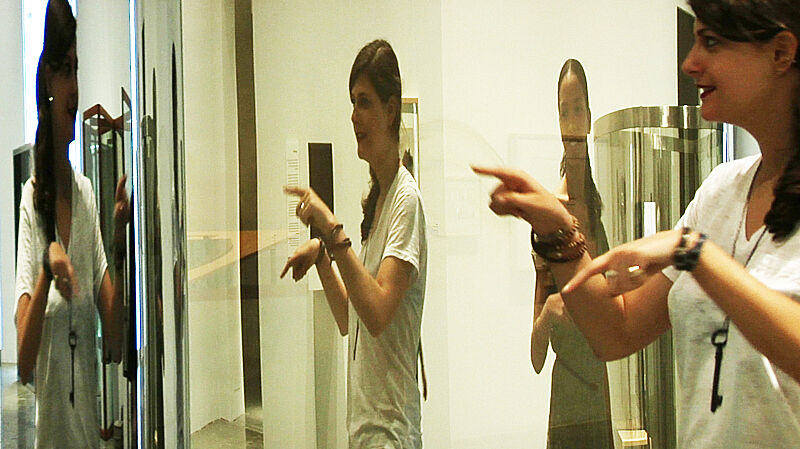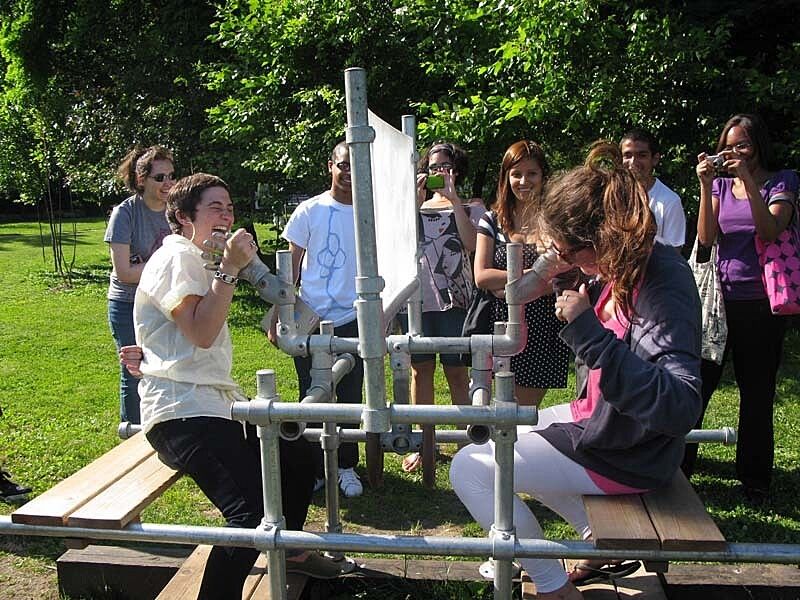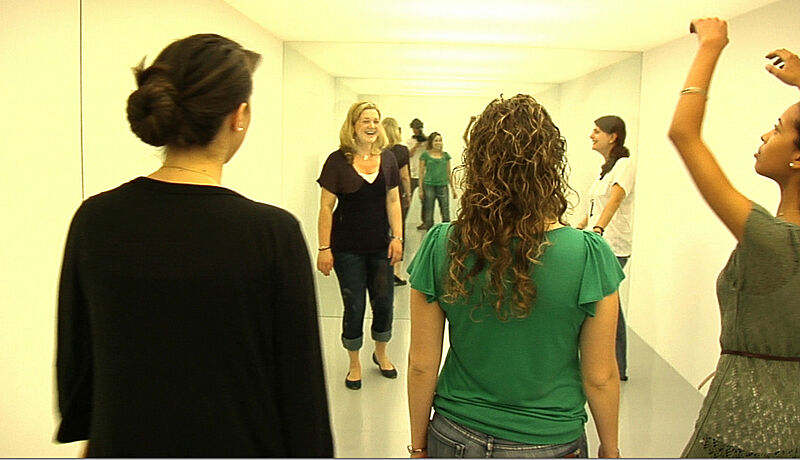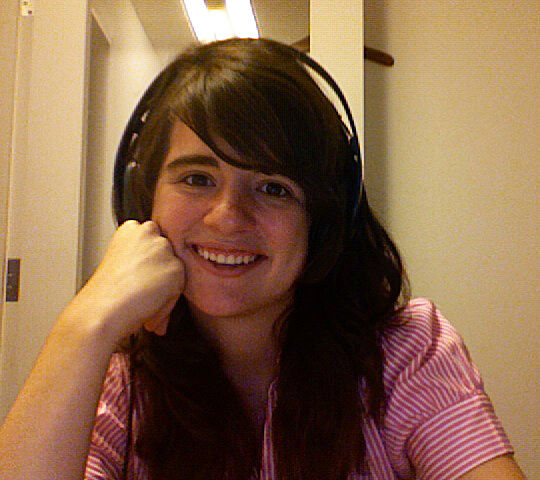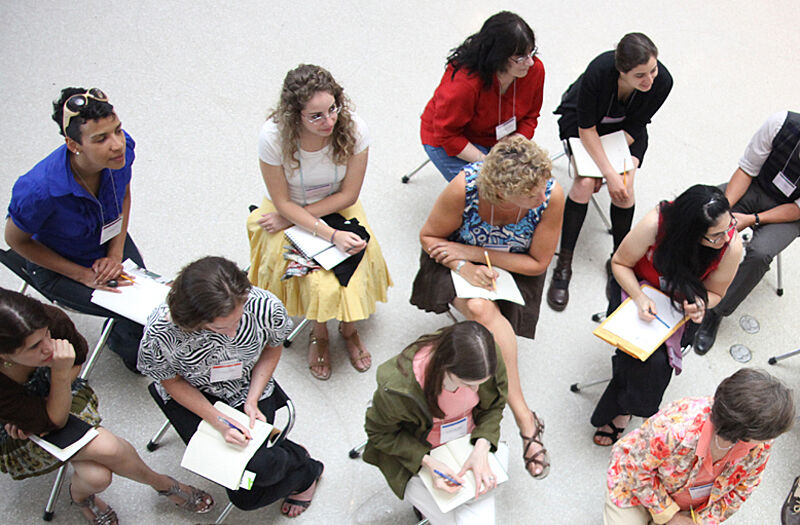Eureka! Summer Intern Stories
Jul 31, 2009
We had a fabulous group of interns this summer--they did a phenomenal amount of work for the Education Department. Read on to find out what they were up to, and what they discovered in the process...
Arm wrestling at Socrates Sculpture Park
I worked with Youth Insights, the Whitney's program for high school students. We went on some field trips to various places in New York City. Youth Insights found the only state fair in New York City at Socrates Sculpture Park. I had no idea that the day would take us through sculptures resembling an obstacle course, a unicorn’s lair and, most trying of all, a strong man competition. WELL. I should have started lifting weights before my summer internship at the Whitney, because Danielle Linzer, Youth Programs Coordinator Extraordinaire, is one formidable arm wrestler.
Once the YIers saw the arm wrestling sculpture and the opportunity for a contest, Danielle and I were doomed. Amid shouts and giggles, we approached the sculpture that mimicked an arm wrestling competition, a staple of every state fair. As I grasped the steel hand, I braced myself for my inevitable defeat. And, oh, the pain that ensued! 30 seconds of pure muscular struggle between two art teachers: an epic match indeed. Relief filled my tired muscles when we finally declared a tie. And I sighed with happiness. I had experienced that rare, elusive Eureka! Moment: art can tone your abs.
By Gillian Sturtevant
Youth and Community Programs Intern
Complex Content
Much of my time spent at the Whitney this summer was dedicated to editing Whitney Focus and Whitney Stories videos. Having absolutely no background in video editing, every aspect presented a huge learning experience for me.
The entire process exposed to me the complexity of creating media content--something I had never given much thought to before. And while the videos we made were always authorized by the individuals in them for authenticity, the process definitely made me think of one of my vices in which there isn't so much emphasis on veracity: Reality TV. I am now more fully aware of how storyline creation is heavily reliant on editing these very types of interviews which I now know happen for the most part between two people, not a person and a camera.
By participating in the video editing process, I've learned so much about the Whitney and the exhibitions within it, and inadvertently become much more cognizant of the possibilities of media footage in the digital age. This realization, I think, speaks to how video today functions as a medium in which the high art/low art binary gives way to something entirely new!
By Sarah Meller
Interpretation and Interactive Media Intern
Comic Books and Zines
Whitneykids Punk Rock was the event of the summer for five to twelve year olds at the Museum! As a part of Family Programs I was asked to design the blank comic books for the art workshop at the event.
On the day of the event, I watched as families poured into the Whitney. Most families went upstairs to the Dan Graham exhibition before venturing downstairs to the Lower Gallery where the workshop was taking place. I spent the first half of the day helping to get the different stations organized and running smoothly.
I didn’t get down to the art making workshop until after the band performed. What I saw took my breath away. There were lots of kids sprawled along the floor, creating the most wonderful comic books. Some kids didn’t use any text but instead used illustrations to tell stories about trips around the world or dogs that could fly. Other kids filled the boxes with funky designs or long dialogues between characters. I loved that everyone was able to use their imagination to come up with great stories in a basic format that allowed for a lot of creativity. It was really cool to see the blank comic books that I had spent days designing turn into wonderful pieces of art.
By Lauren Hobby
Family Programs Intern
Got Juice?
I felt like a bit of an imposter when on the first day of my Whitney internship. We all went around and said how we'd ended up here. I'm an art history major and I love it, but my background is in journalism and publications. So this summer, I was assigned to work on interpretive materials in the Education Department. One of my favorite projects was to help write some of the biographies of the artists that are going to be featured on the whitney.org website.
My first draft bio was what you might expect—a basic chronology of an artist's life. I sat down with Kathryn Potts, Director of the Education Department, to review it. "The good news is, you can write," she said. Phew! "But," she added, "can't you make it juicier? At first I was confused. "A biography has to be chronological," I insisted, "otherwise how will anyone will be able to follow?" "I just think we need a hook," Kathryn replied.
Suddenly, I understood: it was like journalism after all! A biography of an artist has to be more than just a timeline—it has to be replete with quotes and anecdotes that make that person come alive on the page or screen. Above all, the reader has to get a quick overview of who the artist is in the first few sentences.
In a few months' time, I'll be able to log on and see those texts. Little did I know, when I sent out all my summer internship applications, that I'd end up doing more writing at the Whitney than I ever would have at a major newspaper!
By Alexandra Perloff Giles
Interpretation and Interactive Media Intern
Anyone and Everyone
I had the pleasure of working with the Education Department on making the exhibition, Dan Graham: Beyond accessible to visitors with disabilities. Now, what does this mean? Nine weeks ago, I would have said “Elevator? Check!” However, the Whitney—along with museums all over the country—is making incredible strides in an initiative to open up the wonders of art for everyone and anyone. So while an elevator is obviously essential in making the museum accessible for visitors with mobile disabilities, large print labels, video transcripts, and sound descriptions are necessary to create an equal environment.
In addition to learning about the existence and details of museum accessibility, I have been able to memorize the Dan Graham exhibition in and out. As a video/installation artist, you can imagine how much work there was to be done for the artist’s exhibition! There are 23 videos that needed to be transcribed and/or described and around 80 wall labels that needed to be enlarged to fit the Smithsonian Guidelines for Accessible Exhibition Design. This summer transformed my ignorance of museum accessibility into a greater understanding and sensitivity for all museum visitors.
By Mica Medoff
Access Programs Intern
Headphones and other Musings
I spent a lot of time with headphones on this summer--listening to, editing, and taking in years worth of recorded public programs. It was an art history education in and of itself, ranging from Robert Frank’s street photographs to Eduardo Sarabia encouraging audience members to take shots of tequila.
Luckily, I got to work on two programs myself--a panel discussion and a live music performance. From taking reservations and publicizing events to making our speakers and performers comfortable and converting the lower gallery into an auditorium or concert hall, the work began long before and ended well after the hour long programs themselves.
It was only as I sat down to write this that I made a connection between these hours of audio and hours of work. Every hour of audio I listened to was the result of hundreds more hours of work. The time that so many unseen and unsung people--from porters to guards, marketing departments to A/V technicians--put in for an event that will be remembered via an hour long mp3 and a few snapshots is remarkable. I hope they’d all say it’s worth it--it certainly was for me.
By Grace Ambrose
Public Programs Intern
Connecting Collections and the Classroom
Who knew that museums had superheroes as employees, changing the world, one teacher at a time? As the School and Educator Programs intern, I’ve had an in-depth view of the professional development we offer to teachers, including our weeklong summer institute, Connecting Collections in collaboration with the Metropolitan Museum of Art, the Museum of Modern Art, and the Solomon R. Guggenheim Museum.
The program focuses on how to integrate art into the curriculum. Museum educators give teachers resources and fresh ideas for teaching their subjects. We illustrate the importance of inquiry-based methods—using open-ended questions, developing critical thinking and literacy skills, giving students the space for independent thought, and providing a platform for group dialogue. My “aha!” moment: museums don’t just put art up on the walls; they recognize the responsibility that we have to our communities and bettering the education system of this country. I’m ready to put on my Wonder Woman belt and get to work.
By Sarah M. Gass
School and Educator Programs Intern

